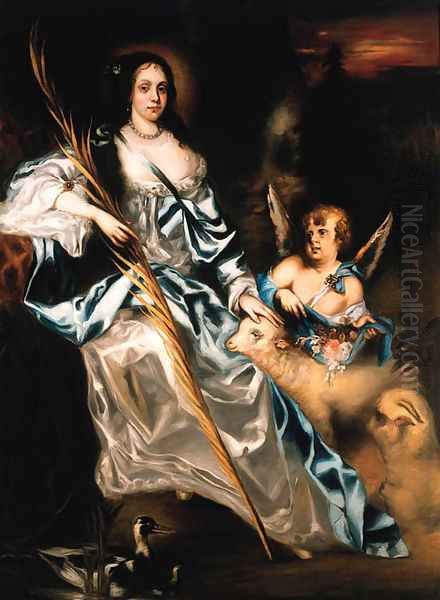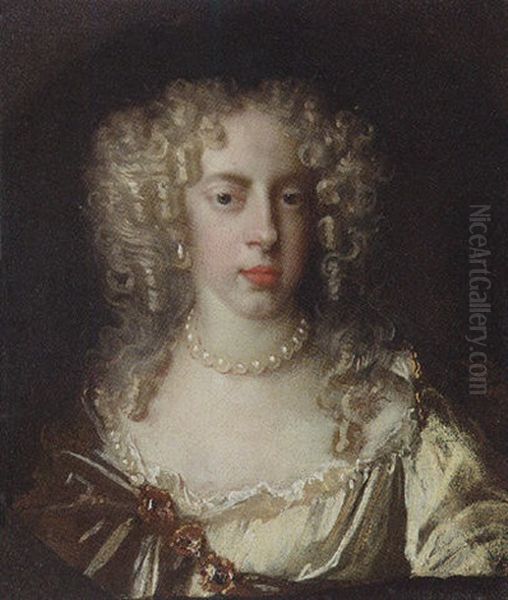Jacob Huysmans stands as a significant figure in the landscape of seventeenth-century English portraiture. A Flemish painter who brought the richness of the Continental Baroque to the court of Charles II, Huysmans carved a distinct niche for himself, admired for his vibrant colours, elaborate compositions, and sensitive portrayal of his sitters. Though often compared to his dominant contemporary, Sir Peter Lely, Huysmans offered a compelling alternative, favoured particularly by Queen Catherine of Braganza, and left behind a body of work that captures the unique opulence and theatricality of the Restoration era.
From Antwerp's Artistic Crucible to London's Court
Born in Antwerp around 1633, Jacob Huysmans emerged from one of Europe's most dynamic artistic centres. Antwerp, even after its 'Golden Age', remained a city steeped in artistic tradition, dominated by the enduring legacy of masters like Peter Paul Rubens and Anthony van Dyck. While specific details of Huysmans' training are scarce, he would have undoubtedly absorbed the prevailing Flemish Baroque style, characterized by rich textures, dynamic compositions, and a certain robustness in portrayal. He likely trained within the guild system before seeking opportunities abroad, a common path for ambitious Flemish artists.
Huysmans arrived in England sometime after the Restoration of the Monarchy in 1660, possibly in the early years of that decade. He entered an artistic scene undergoing significant change. The demand for portraiture, always high amongst the aristocracy, surged with the return of the monarchy and its court. While the influence of Van Dyck, who had died in 1641, still loomed large, setting a standard for elegant court portraiture, there was space for new talents. Sir Peter Lely had already established himself as the leading court painter, but Huysmans' arrival introduced a different, arguably more flamboyant, flavour derived from his Antwerp background.
A Favoured Painter at Court: Patronage and Rivalry

Huysmans quickly found favour within the highest circles of English society. His talent was recognized at court, and he became particularly associated with Queen Catherine of Braganza, the Portuguese consort of Charles II. Catherine, a devout Catholic, may have found a kindred spirit in Huysmans, who maintained his own Catholic faith throughout his life in predominantly Protestant England. This connection likely contributed to the significant patronage she bestowed upon him. He painted the Queen numerous times, often in allegorical or pastoral guises that became highly influential.
His success inevitably brought him into competition with Sir Peter Lely, the dominant force in Restoration portraiture. Lely, German-born but Dutch-trained, had inherited Van Dyck's mantle and developed a highly successful studio practice, producing portraits known for their languid elegance and sophisticated, albeit somewhat standardized, poses. Huysmans offered a distinct alternative. The famous diarist Samuel Pepys recorded his impression in 1664 after visiting Huysmans' studio, declaring his work "exceeds Lilly's". Pepys admired a portrait of Queen Catherine depicted as Saint Catherine, praising its artistry.
This rivalry was played out in the commissions they received. While Lely painted the famous "Windsor Beauties" series for the Duchess of York (Anne Hyde, whom Huysmans also painted), Huysmans created his own celebrated portraits of court ladies, often employing more complex settings and richer colour palettes than Lely typically used. Though Lely maintained a larger and perhaps more consistently fashionable practice, Huysmans secured a loyal following and significant royal patronage, demonstrating that there was room for different artistic visions within the Restoration court. Other portraitists active during this period included John Riley, who later became Principal Painter alongside Godfrey Kneller, the talented female artist Mary Beale, and the Dutch painter Gerard Soest.
Artistic Style: Baroque Flair and Flemish Richness
Huysmans' style is deeply rooted in the Flemish Baroque tradition but adapted for his English clientele. His work is characterized by a boldness and vibrancy that distinguishes it from the sometimes more subdued elegance of Lely. He employed rich, saturated colours and paid meticulous attention to the rendering of luxurious fabrics – silks, velvets, and brocades shimmer with tangible texture in his portraits. This delight in surface and detail aligns with Flemish artistic sensibilities, seen in the work of earlier masters.

His compositions are often more elaborate and theatrical than Lely's. He frequently incorporated allegorical elements, pastoral settings, or mythological references, reflecting the intellectual and cultural interests of the court. The depiction of Queen Catherine as a Shepherdess, for instance, places the royal sitter within an idealized Arcadian landscape, a popular convention of the time. Similarly, portraying her as Saint Catherine of Alexandria connected her piety with her namesake saint, a gesture particularly resonant given her Catholic faith.
Huysmans demonstrated a particular skill in capturing the individuality of his sitters, despite the formal constraints of court portraiture. His handling of light and shadow could be dramatic, modelling faces and forms with a strong sense of volume. While some contemporaries might have found his style occasionally bordering on the flamboyant or "热情奔放" (enthusiastic and unrestrained), as noted in later descriptions, it undeniably possessed energy and visual impact. This approach contrasted with the smoother, more generalized finish often found in Lely's studio output, though Lely himself was certainly capable of powerful characterization. Huysmans' work shows an affinity with aspects of the broader European Baroque, perhaps echoing the drama found in Italian artists like Guido Reni or the rich colourism of Venetian painting, filtered through his Flemish training.
Notable Works and Sitters
Among Huysmans' most celebrated works are his portraits of Queen Catherine of Braganza. The Queen Catherine as a Shepherdess (c. 1664, Royal Collection) is a prime example of his pastoral mode, showcasing intricate details in the costume and landscape, and presenting the Queen in a charming, idealized manner. The Queen Catherine as St Catherine (mentioned by Pepys, versions exist) highlights his ability to blend portraiture with religious iconography, a commission perfectly suited to the Queen's piety and his own Catholic background. These portraits were reportedly very popular and widely copied, setting a trend among court ladies.
Another significant work is the Portrait of Izaak Walton (c. 1670s, National Portrait Gallery, London). Walton, the famed author of 'The Compleat Angler', is depicted with a quiet dignity and intellectual presence. The painting is noted for its sensitive characterization and sober palette, demonstrating Huysmans' versatility beyond flamboyant court commissions. It remains one of the most recognized images of the writer.
His portrait of the notorious wit and libertine John Wilmot, 2nd Earl of Rochester (c. 1670s, National Portrait Gallery) is a fascinating study. It depicts the Earl crowning a monkey with laurel leaves, an allegorical commentary perhaps on satire, mimicry, or the inversion of status. This painting is often cited in discussions of Rochester's provocative persona and relationship with court culture. It showcases Huysmans' ability to engage with complex intellectual themes within portraiture.
Huysmans also painted other key figures of the era, including James Scott, Duke of Monmouth (Charles II's illegitimate son), and Anne Hyde, Duchess of York (James II's first wife). His portrait of Frances Stuart, Duchess of Richmond and Lennox, as Pallas Athena (Royal Collection) is another notable example, depicting the celebrated court beauty in mythological guise. He is also documented as having painted some court ladies in masculine attire, reflecting a curious trend of the period seen also in Lely's work, possibly linked to court masques or a playful engagement with gender roles.
Catholicism in Restoration England
Jacob Huysmans' adherence to Catholicism is a noteworthy aspect of his life and career in England. Following the Reformation, Catholicism was officially proscribed, and although enforcement varied, Catholics faced legal restrictions and societal suspicion. The Restoration period under Charles II saw moments of relative tolerance, particularly within the court circle, influenced partly by the King's own leanings and Queen Catherine's open practice of her faith.
Huysmans' faith does not seem to have been a major impediment to his career, especially given his strong connection to the Queen. It likely facilitated his relationship with Catherine and other Catholic patrons. His willingness to undertake explicitly Catholic iconography, such as the St Catherine portrait, suggests a comfort level perhaps not shared by all artists working in England at the time. This religious identity adds another layer to his position as something of an 'outsider' – a Fleming and a Catholic – operating successfully within the highest echelons of the English establishment, a testament to both his artistic skill and the complex religious dynamics of the Restoration court.
Later Years and Lasting Legacy
Jacob Huysmans continued to work through the later decades of the seventeenth century, though the arrival of Godfrey Kneller in the mid-1670s introduced another major talent who would eventually succeed Lely (who died in 1680) as the dominant court painter. Kneller's more direct, slightly cooler style, influenced by continental trends, came to define the look of the late Stuart and early Georgian periods. Nonetheless, Huysmans maintained his practice.
He died in London in 1696 and was buried in St James's Church, Piccadilly, a church frequented by artists and members of the court. His death marked the end of a significant career that had spanned over three decades in England.
In art history, Jacob Huysmans is recognized as a key portrait painter of the Restoration era. While often living in the shadow of the prolific Sir Peter Lely, he is valued for offering a distinct and vibrant alternative. His work provides invaluable visual documentation of the personalities and the luxurious, complex culture of Charles II's court. His Flemish roots are evident in his rich technique and bold compositions, infused with the drama of the Continental Baroque. He successfully navigated the competitive London art world, securing royal favour and leaving behind masterpieces like the portraits of Queen Catherine, Izaak Walton, and the Earl of Rochester. Though perhaps less consistently influential than Lely or Kneller, Huysmans' contribution enriched the tapestry of English art, demonstrating the fruitful exchange between British patronage and European artistic traditions. His paintings continue to engage viewers with their technical brilliance, historical significance, and the vivid personalities they portray, securing his place as a master of Restoration portraiture alongside contemporaries like John Michael Wright, and within the broader European context of Baroque painters such as Hyacinthe Rigaud or Charles Le Brun in France, whose work reflects similar concerns with courtly grandeur.